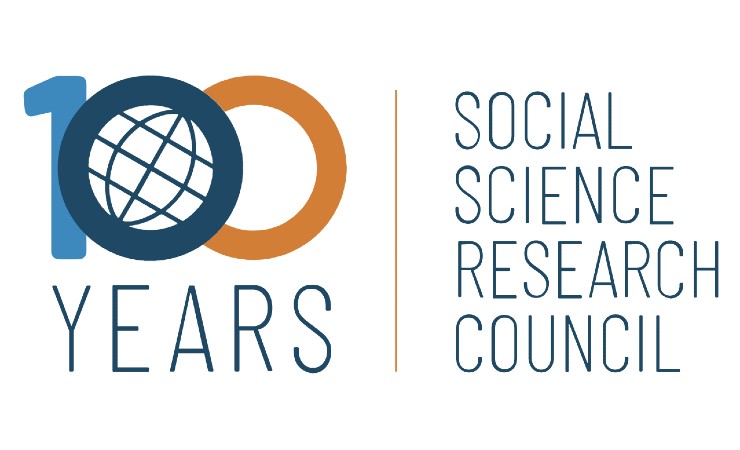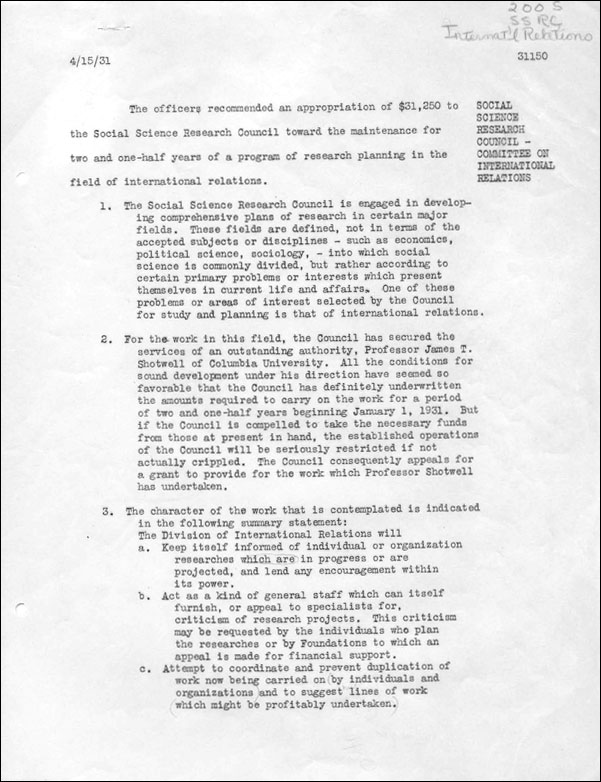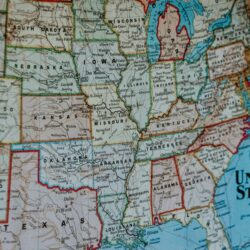Social Science Research Council Turns 100: The Early Years

This article is the first in a series celebrating the 100th anniversary of the Social Science Research Council—a New York City-based independent nonprofit dedicated to mobilizing research in the social and behavioral sciences. In addition to its international role in advancing social and behavioral science research for the public good, the SSRC is of special interest to Sage (the parent of Social Science Space) because Sage’s founder, Sara Miller McCune, sits on its board of directors.
In 1939, the Social Science Research Council (SSRC) was called upon to assist Swedish economist Gunnar Myrdal in his study of anti-Black discrimination in the United States. Myrdal’s project, aided by the SSRC, was eventually published as An American Dilemma: The Negro Problem and Modern Democracy. It was a text that would later be cited by the US Supreme Court in the landmark 1954 case, Brown v. Board of Education, which ruled that racial segregation in public schools was unconstitutional.
This scenario—in which social science research leads to real-world change—is as central to the SSRC now as during its foundation.
The origins
A little over a hundred years ago, the American Political Science Association founded a political research committee to explore the challenges facing policy-relevant social and behavioral science. The committee identified several key barriers preventing social and behavioral science research from impacting public policy, including:
- An absence of complete data collections
- Racial, class-based, and nationalistic bias in data interpretation
- A necessity for precise standards of measurement
- Difficulty pinpointing causal relationships between phenomena
- The lack of controlled experiments in social and behavioral science research
In response to these challenges, the Social Science Research Council formed.
The council’s first meeting included members from the leading social science societies of the day such as the American Economic Association, American Political Science Association, American Sociological Association, and American Statistical Association. Within a few years, the council was joined by representatives from the American Anthropological Association, American Historical Association, and American Psychological Association.
At the time, there was no National Science Foundation or other federal government-level organization supporting social and behavioral science. The NSF would not be created until 1950, and despite earlier testimony from the council before Congress that it should, the foundation wouldn’t include any social or behavioral science aspects in its first five years. In the meantime, and in many respects well into the 1960s, the SSRC served as the de facto national clearinghouse for the social sciences.

The council hired its first full-time salaried staff member, Robert S. Lynd, in 1927. By 1931, Lynd was joined by four additional staff members, and the council’s small staff size has increased ever since. From 1943 through 1973, the council maintained a staff ranging from four to 10 members; most staff members were also academics who worked a few years with the council before returning to their universities. Few staff members stayed with the council for long, which fulfilled the council’s desire to avoid stagnation and maintain creativity. In 1973, the staff increased to 16 employees. Today, the council has 41 program staff and 15 administative staff.
As a private organization, the SSRC received much its funding—and continues to do so—through philanthropic foundations such as the Rockefeller Foundation and Ford Foundation.
SSRC through the decades
Throughout its hundred-year tenure, the SSRC has sought to deploy social and behavioral science research for the public good by mobilizing research, operating fellowships, and serving as an intermediary between researchers and the foundations who fund them.
In response to restrictive immigration policies of the 1920s, the council’s first task was to understand the economic impact of immigration. While many believed that immigration reduced literacy levels and hampered the economy, the council reported on the economic and societal benefits of immigration, including higher literacy rates among immigrant children.
Other early committees include those focused on agriculture, crime, industrial relations, pressure groups and propaganda, and government statistics and information services. Interestingly, the SSRC established several committees invested in the study of Black Americans and interracial relations in the US, but these committees were disbanded by the 1930s. For several years, the SSRC refrained from this field of study. For example, SSRC considered joining but ultimately did not support W. E. B. Du Bois’s long-planned Encyclopedia of the Negro project. Within a decade, though, the SSRC changed course and supported Gunner Myrdal’s research, as noted earlier. (Further analysis into the SSRC’s approach to race relations can be found in their digital forum, Items.)
During the Great Depression, the Rockefeller Foundation requested SSRC research and suggest different forms of social insurance, including social security, to assist the New Deal priorities of President Franklin Roosevelt. The Rockefeller Foundation later funded the council’s Committee on Economic Growth, which was led by economist—and future winner of the Nobel Memorial Prize in Economic Sciences—Simon Kuznets.
In the presidential election of 1948, national and local pollsters from Gallup to small-town newspapers predicted Thomas E. Dewey as the winner. When Harry Truman won in a surprise upset, it shocked both the nation and academia. If the pre-election polls were so inaccurate, did this mean that all surveys—including those utilized in social science research—were useless? Social scientists needed answers, and the SSRC was quick to respond. The council mobilized a technical staff of five, assembled by the Committee of Analysis of Pre-election Polls and Forecasts, to investigate how so many pre-election polls could have turned out in favor of the wrong candidate. The resulting 396-page report uncovered several polling errors while reaffirming the validity of survey methods in general.
After World War II, the SSRC split its focus into two key fields: area studies and behavioralist social science. For a time, these two fields were pursued simultaneously. But post-Cold War shifts in public attitudes toward public investment in social and behavioral science research caused the SSRC to close its area committees and replace them with a more international program. In the 1980s, the council turned their attention to the problem of urban poverty, and in the 1990s, this attention turned to the climate crisis. The SSRC established the Global Environment Change research committee to study the “long-term, large-scale interfaces of humanity, technology, and the global environment.”
What’s next
“An anniversary is an appropriate occasion to recall the past, and this history has been published so that others may share with us this rich inheritance.,” writes Eleanor Bernert Sheldon, the first female president of the SSRC, in the forward of the 1974 publication, The Social Science Research Council: The First Fifty Years. “But an anniversary is also an occasion to restate purposes and to look toward the future.”
Our next article will focus on the role of the SSRC on modern social and behavioral science research—including their COVID-19 response—and discuss the SSRC’s mission for the next hundred years.





























































































